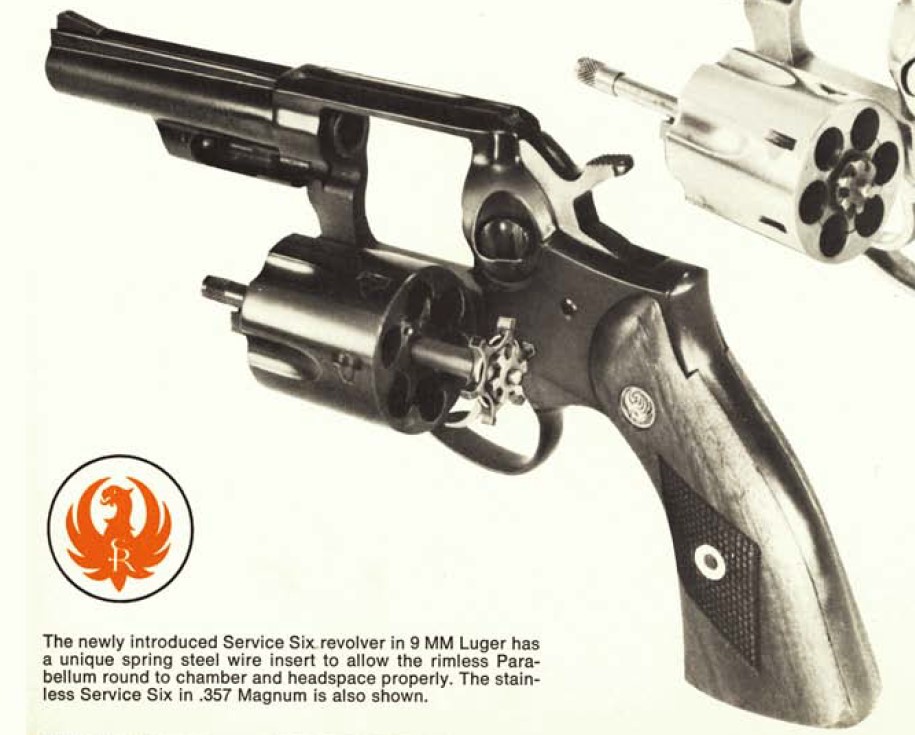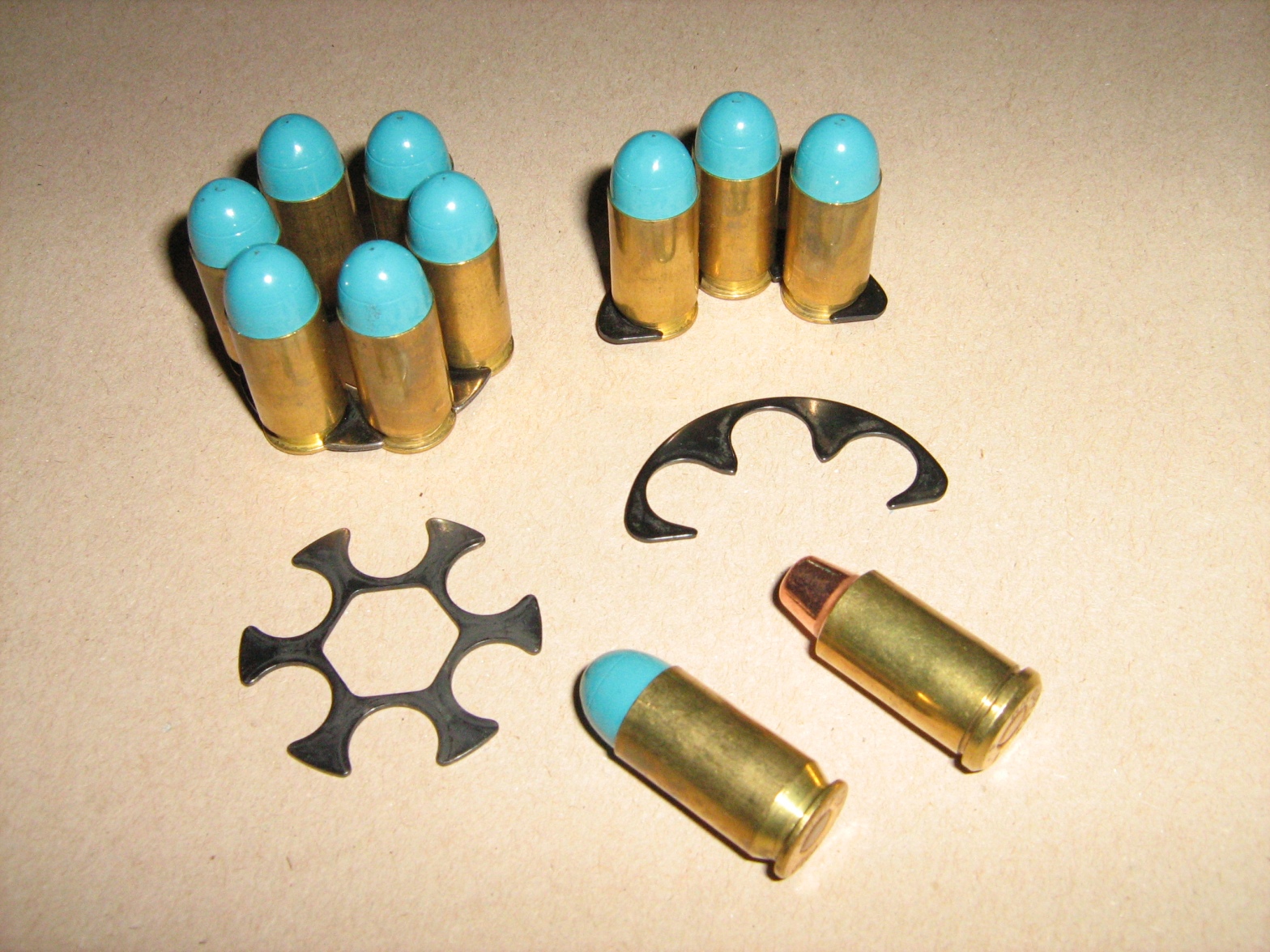Smith & Wesson had full-moon clip patents years before the half-moon clip was patented. Given some of the schemes tried, I suspect that they were worried about how the loaded clips could be carried without damaging them. The most cynical part of my brain wonders if some insisted on them being able to be carried in cartridge belt loops.
US Patent #684,752 shows an early S&W scheme dating to 1901. The designers intended the clip for use with either rimmed or rimless cartridges. Besides the clip, one might suggest that some of the modern rimless cartridge revolvers were inspired by the ejector depicted in the patent.
http://www.google.com/patents/US684752
While they were not the first to file for a patent, Webley & Scott in the UK beat everyone to the commercial market with the full moon clip used in the Webley-Fosbery revolvers chambered in .38 ACP. Awarded GB190118294 in 1902, their patent drawings do not show the exact commercial configuration, but it does show their intent for an 8-shot variant.
https://worldwide.espacenet.com/publicationDetails/biblio?CC=GB&NR=190118294A&KC=A&FT=D#
During the US Army’s early .45 semi-auto pistol trials, a rimmed version of the .45 ACP case was developed in 1906 for testing in revolvers. The cartridge had a standard rim thickness, not the thicker rim of the .45 Auto Rim. It looks like they also drew up a semi-rimmed version in hopes that the cartridge could be used interchangeably between revolvers and semi-auto pistols.
US Patent #881,437 from 1908 shows a full-moon clip in an arrangement similar to what folks achieved decades later when they tack-welded two half-moon clips together. While this one is half assigned to Joseph H. Wesson, the inventor Elmer E. Neal would go on to invent what some wags like to call the “snowflake” clip (US Patent #923,068).
http://www.google.com/patents/US881437
http://www.google.com/patents/US923068
In 1916, Joseph Wesson patented a couple of different full-moon clip designs to work around Neal’s 1909 patent: US Patent #1,202,342 and US Patent #1,202,343. Earlier the same year, Wesson had come up with a modified extractor that would not require the use of clips at all: US Patent #1,181,417.
http://www.google.com/patents/US1202342
http://www.google.com/patents/US1202343
http://www.google.com/patents/US1181417
The definitive half-moon clip design was patented by Wesson in 1917: US Patent #1,231,106. Note that he also shows a “half-snowflake” clip and a multi-jointed full-moon clip that could pivot out completely flat. The latter in my mind points to the desire to use cartridge belt-loops. While the GI half-moon clip carrier would hold two clips per flap, the clips were carried side by side with the open side of the clips facing in towards the belt, not each other.
http://www.google.com/patents/US1231106
FWIW: In 1918, Wesson patented another half-moon clip variant that supposedly limited the movement of the clip when the cylinder was loaded, but I’m not entirely certain as to the whole point of it: US Patent #1,258,170.
http://www.google.com/patents/US1258170
Wesson also developed what would be a wet dream for some ICORE shooters, a multiple refill speedloader: US Patent #1,228,505. In some ways, this was an offshoot of the earlier Rollin White patents for belt-mounted, multiple refill speedloaders for top-break revolvers.
http://www.google.com/patents/US1228505
Ejector Schemes for Rimless cartridges
Some folks would never accept the utility of moon clips, leading to rimless equivalents of the semi-auto cartridges like the .45 Auto Rim and the 9mm Federal. Other users wanted to be able to use the standard semi-auto cartridge, but not have to worry about reliable ejection. This would ultimately lead to conventional revolver speedloaders being made for semi-auto cartridges.
As mentioned before, Joseph Wesson started down this road in 1916 with US Patent #1,181,417.
http://www.google.com/patents/US1181417
S&W’s William Gunn would examine the need for rimless cartridge extraction again in 1971 with US Patent #3,755,950. This one seems awkward as it appears to require partial depression of the ejector rod during loading to allow the extractor to slip into the extraction groove of the rimless cartridges.
https://www.google.com/patents/US3755950
Korth Combat
I cannot find a patent for Willi Korth’s rimless extractor design. It is clear that he had the idea for interchangeable cylinders by 1964 though. The beauty of Korth’s design is that the spring-loaded extractor flanges do not engage the 9x19mm cartridge during loading of the cylinder, unlike several of the other designs discussed below. The flanges only extend until the ejector rod is depressed.
https://kortharms.com/en/wechseltrommel-national-standard-184.html
Manurhin MR73
Manurhin had a pair of competing designs for its 9x19mm cylinders, filed in France in 1974 and in the US in 1975. The first was from Andre Pilorget, resulting in US Patent 3,982,346. This used a multi-layer extractor star, with the centerpiece twisting out to engage the case rims. The second was from Gilbert Maillard, resulting in US Patent #4,015,356. The latter used individual wire springs mounted horizontally to snap into the extractor grooves. (FWIW: I’ve only seen examples of the Pilorget design.)
https://www.google.com/patents/US3982346
https://www.google.com/patents/US4015356
Ruger Speed-Six/Service-Six
Ruger briefly offered a trick extractor for its 9x19mm cylinders, which used a simple wire spring positioned radially on the extractor. Unfortunately for Ruger, S&W’s Harold Sibley and Donald Fogg had already filed patent applications in Belgium, Brazil, France, Italy, West Germany, and the US, starting in July 1975. Only the US failed to grant the patent. Ruger was thus forced to revert to moon clips.
https://worldwide.espacenet.com/patent/search/family/024376321/publication/FR2317621A1

S&W Model 547
S&W’s Roger Curran filed a patent application for the company’s final concept for a rimless cartridge extractor in 1977. Curran’s design used a collet style arrangement with individual spring fingers to engage the case rims.
https://www.google.com/patents/US4127955
http://cosmolineandrust.blogspot.com/2007/11/sunday-smith-22-model-547-1982.html
Phillips & Bailey Ultra
Jonathan Phillips applied for US Patent #4,543,741 in June 1982. George Flippin filed a follow-on application for US Patent #4,541,193 in January 1984. Both designs used a collet extractor design, but they were deemed to be different enough from S&W’s to be patentable. Advertisements for the S&W Model 19 Ultra conversions began to appear in early 1984.
https://www.google.com/patents/US4541193
https://www.google.com/patents/US4543741

Phillips & Rodgers Medusa
Ted Bailey bowed out in June 1992, assigning his patent rights to Jonathan Phillips. Phillips & Rodgers existed as early as February 1993, with the patent application for US Patent #5,341,587 being filed that month. It looks like they were originally going to offer cylinder conversions again, but the first patent applications for what became the Model 47 Medusa revolver were filed in 1995.
https://www.google.com/patents/US5341587
http://www.mythicarmory.com/phillips–rodgers-model-47-medusa.html
Colt Survivor
Circa 1998, Colt’s Joe Cartabona approached Jonathan Phillips about licensing the Medusa’s rimless extractor design. Phillips & Rodgers was to provide the cylinders to Colt to be mated with Magnum Carry frames. There was at least one prototype with a six-shot cylinder, but production units were to be five-shots. Prototypes were displayed at the 1999 SHOT Show, resulting in approximately 25,000 orders The whole plan blew up in Phillips & Rodgers’ face when Colt massacred its non-M1911 handgun lineup in October 1999.
http://www.mythicarmory.com/colt-survivor.html
Charter Arms Rimless Revolver – AKA: The Pitbull
The Charter Arms Rimless Revolver was first announced in 2008, but did not come to market until 2011 as the Pitbull. Curiously, Charter Arms did not file its first patent application until November 2011. D Nickerson Ecker’s definitive patent application was filed in November 2012, resulting in US Patent #8,733,010. Ecker’s design relied on spring loaded tabs protruding from the extractor body to engage the case rims.
https://www.google.com/patents/US8733010
https://charterfirearms.com/collections/pitbull
Korth Sky Marshall / Sky Hawk
The Sky Marshal was a limited edition for an European LE agency, with as few as 77 units made for retail sale in the US. It was unveiled in the US in 2015, with the US importer Nighthawk Custom relabeling it as the Sky Hawk.
https://www.nighthawkcustom.com/sky-hawk-9mm
http://www.mythicarmory.com/korth-sky-marshal.html
Around the same time, Korth also teased an S&W L-Frame 9x19mm conversion cylinder kit. However, I don’t think these were ever imported.

